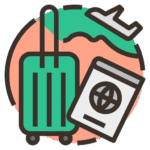Japan Rail Pass
Guide for Travelers
Essential Travel Tools for Japan
Every trip starts with the basics. These tools are the backbone of traveling in Japan. From transport to internet, we’ve listed the essentials every visitor needs — with direct links to our in-depth guides.
My First JR Pass Adventure
The moment I clutched the JR Pass in my hands, it felt like holding a golden ticket to a futuristic wonderland. I was standing in the bustling ticket office at Tokyo Station, surrounded by the hum of announcements in Japanese and the hurried footsteps of commuters. My heart raced with a mix of nerves and excitement, like a kid about to step onto a rollercoaster for the first time.
This small booklet, crisp and official, was my key to Japan’s legendary bullet trains—the Shinkansen. Sleek, silent, and futuristic, it carried me from Tokyo to Kyoto with a precision and grace that felt like stepping into another world. Gazing out the window at Mount Fuji as the countryside blurred past, I realized: this wasn’t just a train ticket. It was a passport to the soul of Japan.
🚄 What Is the JR Pass?
- Unlimited JR train travel nationwide
- Valid for Shinkansen (except Nozomi/Mizuho)
- Options: 7, 14, or 21 days
- Extras: JR buses, Miyajima ferry, Tokyo Monorail
💴 JR Pass Prices & Value
| Pass Type | 7 Days | 14 Days | 21 Days |
| Ordinary | ¥50,000 | ¥80,000 | ¥100,000 |
| Green (1st Class) | ¥70,000 | ¥111,000 | ¥140,000 |
💡 Example fares without JR Pass:
- Tokyo ⇄ Kyoto: ¥17,950 one way
- Tokyo ⇄ Hiroshima: ¥23,480 one way
- Tokyo ⇄ Fukuoka: ¥27,620 one way
👉 Just 2–3 trips cover the full JR Pass cost!
🗾 Coverage: Where You Can Travel
- ✅ All JR Shinkansen except Nozomi/Mizuho
- ✅ JR express, rapid & local trains
- ✅ Tokyo Monorail to Haneda
- ✅ Tokyo Monorail to Haneda
- ✅ Selected JR buses
⚠️ Not valid on subways or private rail lines.
Where to pick up your JR Pass?
🌍 Regional JR Passes
🔑 How to Use the Japan Rail Pass – Step by Step
Using the Japan Rail Pass (JR Pass) is simple once you know the flow. Below you’ll find the complete process — from purchase to riding your first Shinkansen — plus an FAQ you can expand as needed.
1 Buy your JR Pass before traveling
- Official JR site → instant confirmation + ability to pre-book seats.
- Authorized retailer → you receive an Exchange Order (voucher) by mail (valid 90 days).
- ⚠️ You cannot buy the nationwide JR Pass inside Japan (except specific eligibility cases).
2 Receive & check your Exchange Order
- It’s not the pass itself — it’s the voucher to swap in Japan.
- Make sure name, passport number and nationality match your passport exactly.
- Bring the physical voucher with you; photos or scans don’t work for exchange.
3 Confirm eligibility
- JR Pass is for visitors under the Temporary Visitor status.
- Residents/students/work visa holders in Japan are not eligible.
- Carry your passport; staff may verify your status at exchange or gates.
4 Exchange the voucher for your physical JR Pass
- Go to a JR Ticket Office (Midori no Madoguchi) — airports & major stations have one.
- Present passport + voucher → you receive your JR Pass booklet.
- Set your activation (start) date — any date within 30 days from exchange.
5 Choose the start date wisely
- Validity runs by calendar days (00:00 to 23:59), not 24-hour blocks.
- If you’re on a train at expiry time, you can complete that ride.
- Plan activation to cover your long-distance days.
6 Pick your pass type
- Ordinary — economy; already spacious and comfortable.
- Green — first-class; bigger seats, quieter cars, more legroom (usually requires reservations).
7 Entering JR stations & ticket gates
- Insert your JR Pass at the automatic JR gates (or use manned gates where indicated).
- Always retrieve the pass — you’ll need it at the exit gate too.
- Keep your pass on you whenever traveling.
8 Reserving seats (recommended on busy routes)
- Reservations are free with the JR Pass.
- Book at ticket offices, reservation machines, or online (when purchased via the official site).
- Some services are reserved-only (e.g., Hayabusa/Komachi/Kagayaki, Narita Express).
9 Riding Shinkansen & limited express trains
- Non-reserved cars are typically Cars 1–3; sit anywhere available.
- For reserved seats, your ticket shows car & seat number.
- Luggage: overhead racks + dedicated areas at car ends on many trains.
10 JR buses & ferry to Miyajima
- Local JR buses in cities like Hiroshima, Sapporo, Kyoto, etc. are included.
- JR Miyajima Ferry is included (Hiroshima ⇄ Miyajima).
11 Combine with IC cards for full coverage
- Use Suica / Pasmo / ICOCA for non-JR subways, trams and buses.
- JR Pass + IC Card = seamless city + intercity travel.
12 Expiry, refunds & reissue rules
- Pass expires at 23:59 of the last valid day.
- Refunds: usually only for unused, unexchanged vouchers (fees apply).
- Lost passes cannot be reissued; damaged ones can be replaced if surrendered.
❓ JR Pass – Frequently Asked Questions
Does the JR Pass cover Nozomi or Mizuho Shinkansen?
No — the nationwide JR Pass does not include Nozomi/Mizuho services. Use Hikari/Sakura instead, or pay the special upgrade surcharge where available.
Is the JR Ferry to Miyajima included?
Yes. The JR Miyajima Ferry is included. Just show your pass at the ferry gate.
Are local, rapid and limited express trains included?
All JR-operated trains are included (local, rapid, limited express and Shinkansen), except Nozomi/Mizuho. Non-JR lines (e.g., Kintetsu, Tokyo Metro) are not covered.
Can I set the activation date later than the exchange day?
Yes. When you exchange the voucher, you can select any start date within 30 days. Popular tactic: exchange on arrival, activate later for your long-distance phase.
Can multiple people share one JR Pass?
No. The pass is personal and tied to your passport. Each traveler needs their own pass.
What if I only travel within a single region?
Consider regional passes (JR East/West/Central/Hokkaido/Kyushu/Shikoku). They’re cheaper and can fit city-based itineraries better.











